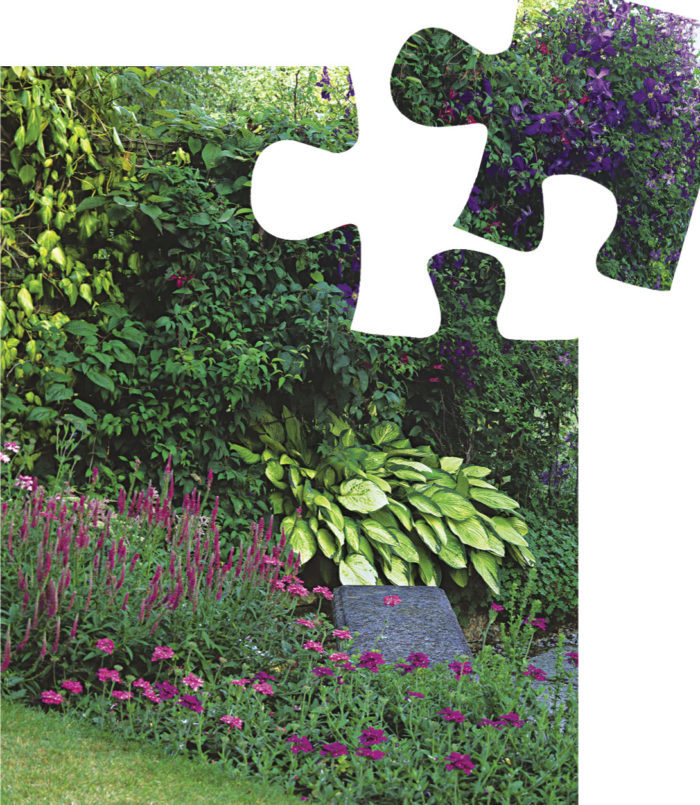
Climbing plants are like a troupe of exceptionally versatile thespians—pleased to perform a myriad of roles in an endless number of plays. Are you in need of a shining star for your garden? There’s a vine with a profusion of bright red trumpets ready to climb up a towering wall. Or perhaps a supporting actor is more of what you had in mind. Don’t worry because there’s a pink-flowering clematis that will happily intertwine with a nearby perennial and distract your eye from the garbage cans below. But many of us often fail to incorporate vines into our gardens because we’re unsure which ones will do well and complement the landscape, not engulf it. When it comes to vines, knowing their growth habit is second only to knowing how much—or how little—sun they need to thrive.
Never was the adage “Right plant, right place” more significant than with vines. Before planting, think carefully about where vines are going to live. Climbing plants also need the right framework. Whether it’s a wire fence to wrap their tendrils around, a wooden trellis to pull themselves up on, or a rough stone wall for attaching their roots, vines require a structure of sufficient size and support strength. Over my many years of growing vines, I’ve come up with a list of spectacular performers that thrive in different exposures and reward the gardener with consistently amazing shows.
These selections love lots of light

Not all vines can take long days of hot blazing sun, but ‘Glasnevin’ potato vine can. With its plethora of small purple flowers and pale orange anthers, this sturdy-stemmed climber will clothe a wall quickly and flower from midspring to fall. Even in colder climates where this beauty won’t overwinter, it is more than worth its price for how long and generously it flowers. You’ll probably need to help attach ‘Glasnevin’ to a sturdy trellis, guiding the stems in the right direction, because the vine doesn’t have tendrils or roots to attach itself. ‘Glasnevin’ looks great when paired with plants that have apricot hues, like ‘Alchymist’ rose or ‘Ghislaine de Feligonde’ rose (Rosa ‘Alchymist’ or R. ‘Ghislaine de Feligonde’, Zones 5–9).
If clematis has intimidated you in the past, consider ‘Polish Spirit’ clematis. With its 4-inch-wide, velvety, deep purple flowers, this cultivar is easily one of the most beautiful and long-flowering that I’ve grown. In summer, when much of the garden quiets down, ‘Polish Spirit’ beams in glory. In early spring, cut the stems straight across, about 18 inches above the ground, and deposit a shovelful of compost at the base of the plant, about 4 inches away from the stems. Then give it two doses of granular rose fertilizer during the remainder of spring. Like all clematis, keep ‘Polish Spirit’ watered when there isn’t rain. This clematis does well on most wooden structures, from fences to trellises.

If you have the space for a tall deciduous climber, try variegated kiwi vine. It’s grown for its 4-inch-long leaves, which look like they’ve been dipped in white paint and then partially redipped in pink paint. The flowers, while fragrant, are insignificant. This plant looks fine on its own, but when put with the right partner, the pairing is to die for. My kiwi vine twirls around a pink-flowering rose, a combination that lures strangers into my yard so that they can take photographs. The strappy stems of this scrambler may need some help growing up, but tying the branches to whatever structure you’d like it to envelop easily solves this problem. Be aware that sometimes the signature variegation of kiwi vine doesn’t show up on young plants, and it won’t get fruit unless you have a male and a female plant (there are better species options if you want tasty fruit). Be forewarned: Cats love variegated kiwi vine—the scent is their aphrodisiac of choice.

Some climbers prefer dimmer conditions

Like people, many vines actually prefer a bit of shade. One of my favorites for a semishady spot is chocolate vine—and not just for its name, though the purple or white flowers sometimes do offer a whiff of milk chocolate on a summer night. Many say the dark flowers are more fragrant, but the cultivar ‘Alba’ gets twinkling white bells, which are beautiful as well. This is a quintessential framework vine because it not only climbs without any assistance but also provides a great backbone for other climbers to grow up. Chocolate vine’s sturdy nature combined with its dainty five-lobed leaves and small drooping flowers make it perfect over a big front door or on a garage.
Few people believe me when I tell them it’s a climbing evergreen hydrangea creeping up my northeast wall. My visitors whisper, not wanting to say that I’m wrong—but I’m not. With its large, rhododendron-like leaves; ruddy stems (providing great interest in winter); and elegant, lacecap-like white flowers, the slow-growing climbing evergreen hydrangea is the perfect vine. Other than combatting a few vine weevils in early spring, it requires only a wall or other rough surface to attach itself to and the occasional long drink.

A daintier option for partial shade is bleeding heart vine, with its exquisite, ferny foliage and dangling, pale yellow flowers. Late to emerge in spring, it will scale its support quickly and put forth a plethora of midsummer blooms. I’ve heard one gardener describe this show as a flock of perching canaries resting in a woodland area. ‘Athens Yellow’ is a newer cultivar with bright yellow blooms that flower from spring to fall. Bleeding heart vine is an ideal candidate if you want something to scamper through spring-flowering shrubs or perennials to add some late-season interest. Even the foliage turns a soft yellow in late summer, effortlessly extending the seasonal interest.

These options thrive in the shadows

There are many “north wallers” more than willing to offer some vertical appeal amid the hostas and ferns in dense shade. For starters, try the blessedly early alpine clematis. Among a number of cultivars, my favorite is ‘Pamela Jackman’. It has 2-inch-wide bluish flowers and wonderfully dissected foliage. The growth occasionally gets exuberant, so in early summer, well after it flowers, I prune the stems back to the boundaries of its trellis. All alpine clematis have amazing seed heads, golden and intricate, lasting well through the winter—an added bonus if ever there was one.
It is rare to see truly bright colors in the shade, but Tellmann’s honeysuckle is an exception. While not fragrant like other honeysuckles, its attractive foliage arrives in early spring, followed by luminescent apricot-colored flowers that startle and dazzle as few others can. This honeysuckle, rising to a height of 10 feet in a couple of years, is ideal for climbing up a tree because it rarely requires pruning and it thrives in deep shade. It’s crucial to keep it well watered because dryness attracts aphids.
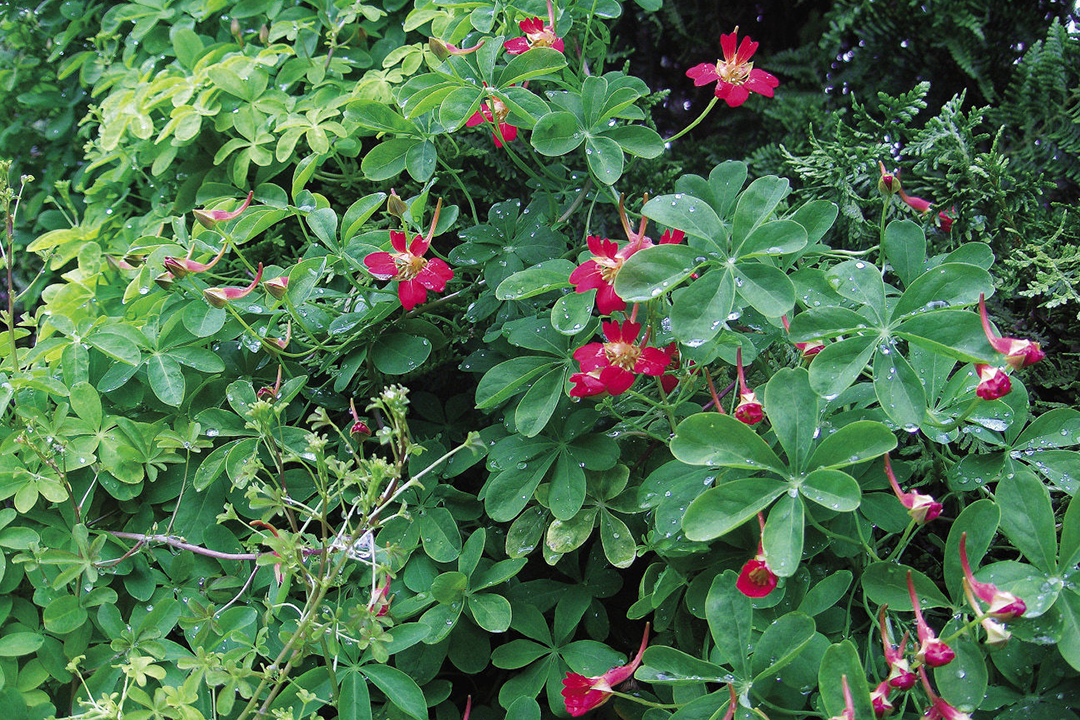
When I ran my nursery, Scottish flame flower, a perennial nasturtium, was my celebrity plant, drawing in buyers from great distances. The slender stems sprint their way up hedges or sturdier climbers (like climbing hydrangea). Its bright, apple green leaves are quite attractive on their own, but in early summer, out pops a profusion of bright red flowers that really draws attention. Regardless of how you feel about red flowers, to see this vine is to want it. The flowers are followed by stunning turquoise berries, which turn to navy blue later in the season. You can gently help direct the stems of this vine, but don’t be too rough or Scottish flame flower will show resentment by going limp.

Vines are important but often overlooked members of the garden cast. When given the right stage, they can enhance the entire show, drawing attention not only to themselves but also to the scene as a whole.
The Art of Training a Vine
Some vines grow where you want them to with little effort; others, however, need a lot more persuasion. Be sure to start all vines off with appropriate support in place from the beginning. Here are a few additional tips to get your vines going in the right direction.
Option 1:
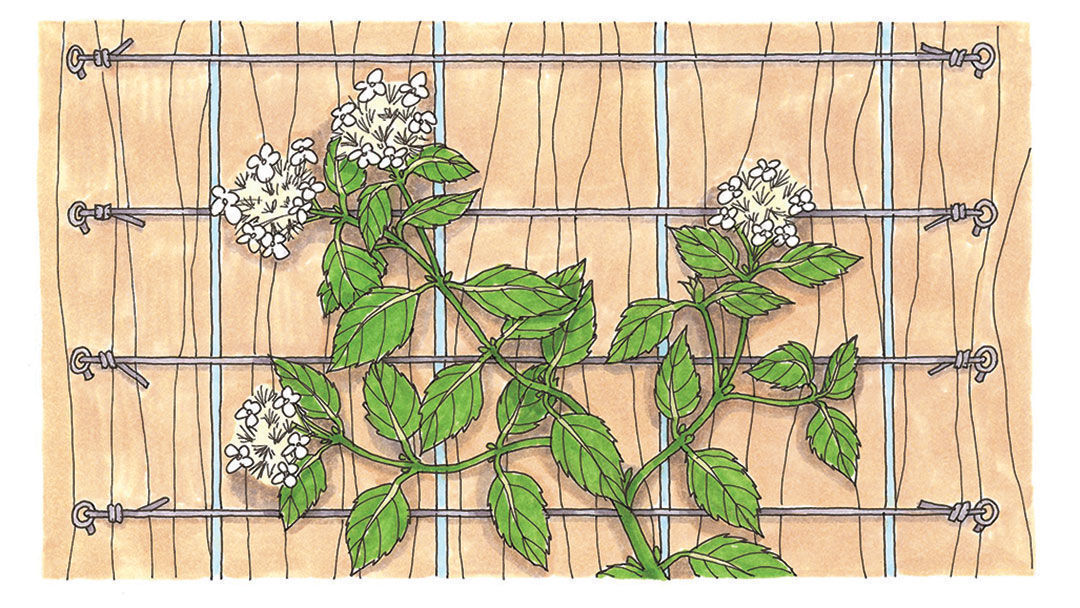
If you want to train a climber up a wall or a solid fence, place wires across it, 8 inches apart, held tightly in place by eye hooks; stucco mesh hung across the surface also works. Make sure the wires or mesh are suspended out from the wall by at least an inch.
Option 2:
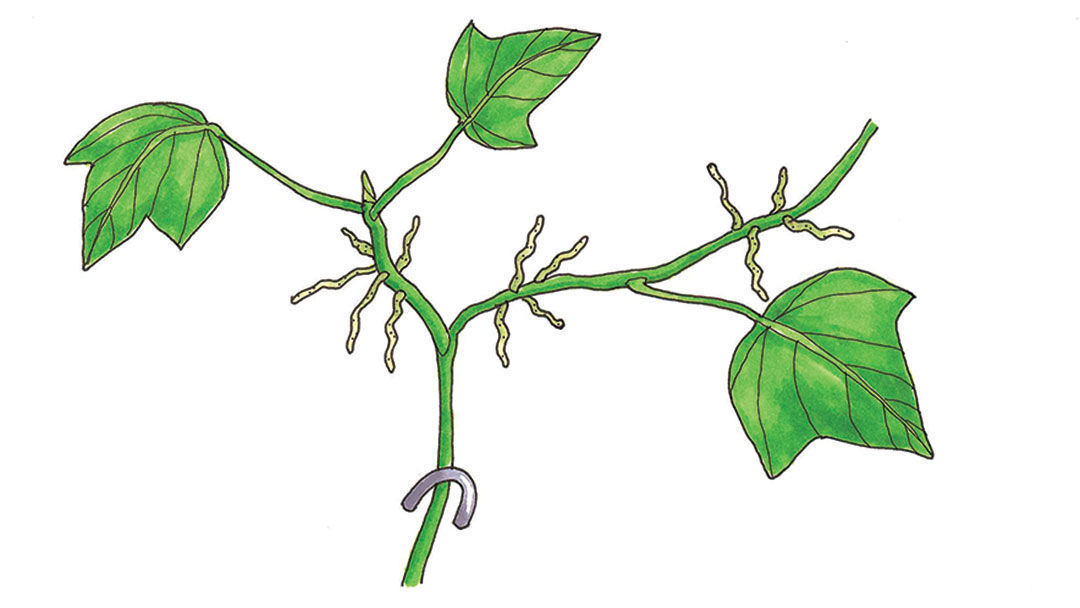
To lead self-adhering plants up walls or solid fences, attach the young stems to the wall with a small horseshoe-shaped nail or staple.
Option 3:

When growing small or medium-size vines up a trellis or another plant, you can use twist ties to loosely attach the climber onto the supports.
Julie Lane Gay gardens in Vancouver, British Columbia, where she formerly owned a nursery specializing in vines.
Photos, except where noted: Bill Johnson. Illustrations: Martha Garstang Hill
The following mail-order plant sellers offer the widest selection of the vines featured:
- Arrowhead Alpines, Fowlerville, Mich.; 517-223-3581; www.arrowheadalpines.com
- Brushwood Nursery, Kennett Square, Pa.; 610-444-8083; www.brushwoodnursery.com
- Forestfarm, Williams, Ore.; 541-846-7269; www.forestfarm.com
- Gossler Farms Nursery, Springfield, Ore.; 541-746-3922; www.gosslerfarms.com
- Thompson & Morgan, Jackson, N.J.; 800-274-7333; www.tmseeds.com
Fine Gardening Recommended Products

Ho-Mi Digger - Korean Triangle Blade
Fine Gardening receives a commission for items purchased through links on this site, including Amazon Associates and other affiliate advertising programs.

Spear & Jackson 4930FZ Razorsharp Telescopic Tree Pruner
Fine Gardening receives a commission for items purchased through links on this site, including Amazon Associates and other affiliate advertising programs.

Buffalo-Style Gardens: Create a Quirky, One-of-a-Kind Private Garden with Eye-Catching Designs
Fine Gardening receives a commission for items purchased through links on this site, including Amazon Associates and other affiliate advertising programs.

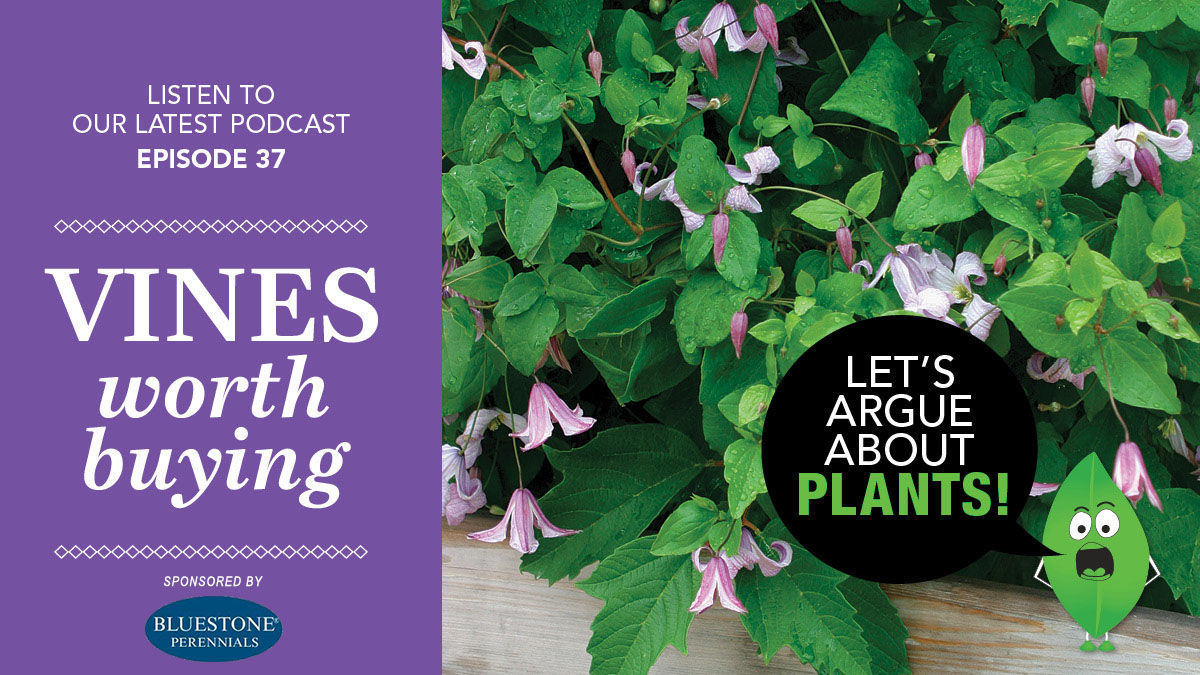
















Comments
Log in or create an account to post a comment.
Sign up Log in